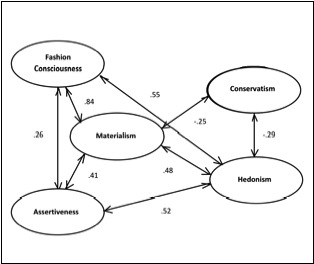Kevin Gray
‘Model’ may call to mind images of Naomi Campbell or Heidi Klum and, indeed, fashion models do play a role in marketing research. One of the most interesting projects I worked on early in my career used perceptual mapping to select fashion models for the client’s advertising. In the process, we learned quite a lot about consumers’ imagery of competitor brands as well.
Regrettably, ‘model’ is normally used in more prosaic ways in our business. As a marketing science person, I probably use it more than most, though several of my qualitative colleagues are also quite fond of the word. It is often used vaguely, however, and there is sometimes confusion about what it means in the context of a specific discussion or email. I plead guilty to contributing to some of these misunderstandings. Drawing upon Wikipedia, Wiktionary, TheFreeDictionary, The Cambridge Dictionary of Statistics and my own experience, I’d like to offer some thoughts on how to lessen the confusion.
We often speak of hypothetical models, business models, marketing models, statistical models, causal models and computer models, to name some common usages. Most people in our field will have at least heard of a regression model, which refers to certain kinds of statistical methods. Occasionally we may mean a physical mock-up or prototype. More often, though, we are vague about what we mean by model. The word sounds cool and we overuse it! While our meaning may be obvious from the context this is not always the case and discussions can meander in circles because the parties involved are talking or writing about different things without being conscious if it. These misunderstandings can have a big impact on research design, costing, project operation and client satisfaction. 1-1-144…remember these numbers. In a bit, I’ll reveal what they stand for.
What Makes a Model?
At its heart, a model is a simplified representation. The most fundamental type of model is conceptual. It is a notion we have about something. Frequently our idea is quite broad and expressed imprecisely. Sometimes, however, it is well-defined and articulated as a theory, and we may even outline it in a diagram or flow chart. That is a second kind of model, what I will call an operational model. A third type is a mathematical equation or system of equations. The equation or equations represent the detailed mechanism, which we will never actually be able to see, that gave rise to the data we are observing. I’ll refer to this as a statistical model. Sometimes it matches our data very well but sometimes it’s considerably wide of the mark. Here’s an equation that fits perfectly:
Degrees Fahrenheit = 32 + 1.8 x Degrees Celsius .
I should note that I am not suggesting a rigid hierarchy or natural progression among the three kinds of models. In practice, they can appear and reappear in any order, often in an iterative manner.
An Illustration
Let’s set abstractions aside and illustrate my model of models with a real example. Several years ago I worked on a usage and attitudes (U&A) study on overseas travel conducted among young, single women in an Asian country. This group is important to the travel industry for many reasons, one being that they often have more freedom to travel during any time of the year than other consumers. Another is that a disproportionate number of them have high disposable incomes.
An important objective of this research was to explore personality factors underlying the preferences of these consumers for overseas destinations and travel arrangements. In the interviews respondents rated themselves on a battery of psychographic items which had been developed partly through preliminary qualitative research. The qualitative phase of the research had suggested five principal psychographic factors of relevance to overseas travel experience and tastes. These were:
- Fashion Consciousness
- Materialism
- Assertiveness
- Conservatism
- Hedonism
Based on the qualitative research and Exploratory Factor Analysis (EFA) of the U&A data, a number of Structural Equation Models (SEM) were developed and tested, each of which hypothesised different inter-relationships among the five latent constructs listed above. To put this into the context of my earlier thoughts about models, in this research, all three types of models played a role in the research. First, we hypothesised that aspects of personality influence preferences for overseas destinations and travel arrangements. That was our conceptual model. This hypothesis was explored in qualitative research and more fully developed in the qualitative and quantitative phases. This led to several alternative operational models. Lastly, the quantitative data were statistically analysed and our thinking on this topic further refined and quantified. These were our statistical models.
Shown below in Figure 1 is a path diagram of the SEM model we concluded was most meaningful in light of the overall findings and business objectives of the research. In the diagram the arrows imply a correlation between factors and the adjacent numbers show the strength of the association. The absence of an arrow means that correlation was not statistically different from zero.

The model equations were more elaborate than those depicted in the diagram and, for space reasons, I’ve omitted the questionnaire items (‘indicators’) used in the modelling. They included statements such as: Fashion is an important means of self-expression (Fashion Consciousness), I am extravagant about my clothes and food (Materialism), I make friends quickly even with people I’ve just met (Assertiveness), I tend to achieve my goals one step at a time (Conservatism) and I want to enjoy the present rather than think about the future (Hedonism).
Unsurprisingly, Fashion Consciousness and Materialism were found to be highly associated (0.84). Materialism and Assertiveness were also found to be positively related but the relationship was less strong. Assertiveness and Fashion Consciousness were also correlated, though weakly. Conservatism and Hedonism were negatively associated, which seems intuitive, though this association also was not strong. We also found that Fashion Consciousness, Materialism and Assertiveness were all moderately positively associated with Hedonism. And, as had been anticipated, Materialism and Conservatism were negatively related in this research, though the relationship was modest.
So what does all this mean? Fashion conscious women are also inclined to be on the spendthrift side and to have a hedonistic streak, though they are not necessarily exceptionally assertive or extroverted. Given these patterns, when vacationing abroad one might expect they would tend to look for an abundance of places to shop, especially for high-priced/fashion goods. Choice restaurants and perhaps nightspots would probably also be considerations for many of them when choosing a travel destination and/or travel package. More conservative or methodical types, on the other hand, tend to be less extravagant, fashion conscious and assertive, and also less hedonistic. Other results from this survey suggested these young women might, instead, be more inclined to enjoy the local flavour of their destination or simply relax.
The foregoing summary is greatly abridged and the data were analysed in numerous ways besides what I have mentioned, which was just one component of the final deliverable. Most importantly, however, is that many of our findings and recommendations became components of the client’s marketing strategy.
The Costs of Miscommunication
Returning to our central theme, though a model has many faces we frequently use the word loosely and misunderstandings arise. One conceptual or operational model might actual imply many statistical models, for instance, by region or consumer group. 1-1-144…a few years ago I was asked to lend a hand on an RFP from a major manufacturer which had proposed one conceptual model, one operational model and, unwittingly, 144 statistical models! When this confusion was recognised, the project design and budget had to be entirely revamped, at considerable time cost to both the client and agency, all as a consequence of the fuzzy use of the word ‘model’. These sorts of mix-ups, unfortunately, are not uncommon and a marketing scientist must always be on guard about them.
In this brief article, the taxonomy of models I’ve outlined is arguably over-simplified. The key point I wish to convey, however, is that whatever we mean by ‘model’, it is essential that we be clear about what we mean. Misunderstandings can have substantial cost repercussions and create large gaps between what is delivered and what the client had been expecting.
Kevin Gray is President of Cannon Gray, a marketing science and analytics consultancy.


